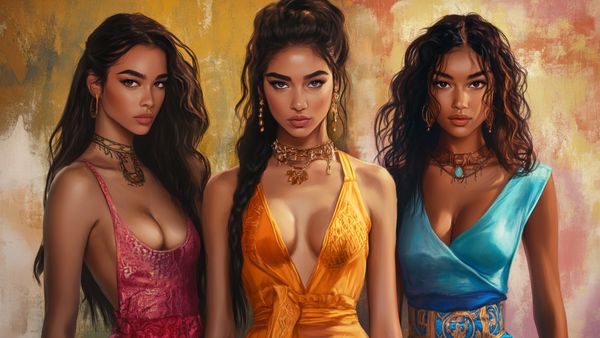1. Ancient Civilizations and the Origins of Neckline Styles
Fashion has always been a mirror reflecting the values, aesthetics, and priorities of a society. In ancient civilizations, clothing wasn’t only about modesty or climate — it was a symbol of identity, class, and status. For example, in ancient Egypt, both men and women wore garments that reflected the hot climate, often with light fabrics and open designs to allow air flow. Neckline styles during this era were more about practicality and comfort, but they still carried meaning — a decorated or beaded neckline could signify higher social standing. Wealthy Egyptians adorned the necklines of their linen garments with precious stones, beads, and intricate embroidery, making the clothing a status symbol. Similarly, in Mesopotamia, garments with draped designs were common, and the way the fabric fell around the neck could indicate whether a person belonged to the royal court or the working class. This early connection between neckline design and social status is a trend that continues to influence modern fashion, where certain cuts, embellishments, and fabrics still signal prestige or sophistication.
2. Greek and Roman Influence on Draped Styles
The Greeks introduced a new elegance to clothing design through draped garments such as the chiton, peplos, and himation. These garments were often belted, pinned, or draped in ways that created soft folds around the shoulders and neck. Rather than using tight stitching, they relied on the natural fall of fabric to form graceful lines. This freedom of fabric movement made the neckline area an expressive part of the outfit, varying from high and covered to wide and open depending on the occasion. Romans, influenced by Greek designs, adapted the toga and stola, adding more decorative elements. The neckline became a canvas for intricate brooches, gold pins, and embroidered borders. While functionality remained important, the Romans placed greater emphasis on aesthetic display, using neckline styles to express dignity, authority, and beauty. This period established the idea that how a neckline is shaped can dramatically change the tone of an outfit — a principle still embraced by today’s fashion designers.
3. Medieval Modesty and Layered Clothing
The Middle Ages brought a shift toward more modest and structured clothing, influenced by cultural values, religion, and colder climates in Europe. Necklines during this period were generally high, often reaching up to the base of the neck or even forming collars that extended upward. This was partly due to modesty standards and partly for warmth. Clothing was typically layered, with an under-tunic, over-tunic, and sometimes a surcoat, each with its own neckline cut. Decorations were common, especially among the wealthy — embroidery, fur trim, and jewels adorned the edges. Despite the modest cuts, tailors used the neckline to showcase craftsmanship, with detailed stitching and contrasting fabrics. This era highlighted how even a fully covered neckline could be an element of beauty and individuality. In noble courts, the height, structure, and embellishment of a collar could communicate rank and wealth without revealing much skin.
4. Renaissance Creativity and Decorative Necklines
The Renaissance marked a cultural rebirth, and fashion reflected this with more experimentation, color, and artistry. Necklines became more varied — from square shapes to rounded curves, often framed with lace or embroidery. Women’s gowns frequently featured wide, low necklines during formal occasions, but they were balanced with decorative collars or ruffs that added grandeur. The ruff, a stiff, pleated collar, became a symbol of wealth and sophistication. Men’s clothing also embraced more open collars, sometimes layered with fine linen shirts peeking through. Fabrics like velvet and silk, along with intricate trims, turned necklines into visual focal points. This was an era when fashion design began to blend artistry with personal expression, and neckline styles were used strategically to enhance portraits, paintings, and public appearances.
5. The Elizabethan Era and the Rise of the Ruffled Collar
In Elizabethan England, necklines became dramatic and structured. The ruff — an elaborate, starched collar — reached its peak, with some extending so wide they required wire supports. This was not a casual fashion choice; it was a deliberate display of wealth, since maintaining such collars required skilled servants and expensive materials. Necklines on gowns could vary beneath these collars, but the focus was on the collar itself as a frame for the face. The high ruff drew attention upward, emphasizing dignity and status. Men’s doublets often had a similar structured collar, sometimes open in front to reveal a richly decorated shirt. This period showcased how necklines could be theatrical, serving not just functional or decorative purposes but also as fashion statements that communicated power and prestige.
6. 17th Century Elegance and Soft Lace Collars
As fashion moved into the 1600s, the extreme ruffs softened into lace-trimmed collars that draped gently over the shoulders. These “falling bands” created a more romantic and approachable appearance compared to the rigid collars of the previous century. The neckline became a point of visual softness in an otherwise structured garment. For women, gowns featured rounded or squared necklines, often with lace edging. Fabrics like satin and silk allowed necklines to drape naturally, giving an air of effortless elegance. This was also a time when portraits often emphasized the beauty of lacework around the neckline, highlighting the craftsmanship and refinement of the wearer. The trend toward softer lines reflected broader cultural changes, including a shift toward comfort and natural grace in fashion.
7. Modern Body Positivity Movement and Diverse Standards
In recent years, the conversation around beauty has taken a much broader and more inclusive turn. The modern body positivity movement has encouraged women to embrace their natural shapes without feeling pressured to fit into a narrow beauty standard. This shift has also impacted how society perceives the chest area, moving away from rigid ideals toward a celebration of variety. Social media platforms have given women from different backgrounds, sizes, and cultures the opportunity to showcase their authentic selves. Representation now comes in many forms — from smaller busts to fuller chests — with equal appreciation for all.
This inclusivity has made a powerful statement: beauty is not confined to a single measurement or curve. Clothing brands have started to design pieces that flatter a wide range of body shapes rather than focusing solely on a “perfect” silhouette. The conversation has expanded beyond aesthetics to health, self-confidence, and self-acceptance. Many public figures and influencers openly discuss body changes due to life events like pregnancy, weight fluctuation, or aging, reducing stigma around natural differences. This has redefined the concept of attractiveness, making it more about personality, self-expression, and comfort than about meeting a particular physical standard.
8. The Role of Celebrity Influence
Throughout history, celebrities have played a significant role in shaping beauty ideals — and that includes how the chest area is viewed. From Hollywood stars of the golden age to modern social media influencers, public figures often set trends simply by being in the spotlight. For example, the glamorous looks of 1950s actresses, with their structured dresses and subtle curves, inspired an entire generation. Fast forward to the early 2000s, and we saw a different influence: red-carpet dresses with deep necklines and bold styling choices, which brought attention to a more dramatic appearance.
Celebrities often collaborate with fashion brands, meaning their personal styles become a form of marketing that can shift public taste almost overnight. The ripple effect of one award-show outfit can spark thousands of similar styles hitting store shelves within weeks. Today, this influence is even more immediate because of Instagram, TikTok, and other platforms where a single photo or video can go viral in hours. Whether the look is bold and attention-grabbing or subtle and understated, celebrities continue to have the power to redefine what is considered desirable — often blending past trends with modern sensibilities.
9. Fashion Technology and the Changing Role of Undergarments
Advances in fashion technology have transformed how people enhance, support, and style their bodies. In earlier decades, corsets and wired bras were essential for achieving the “ideal” shape of the time. However, modern technology has introduced a range of options, from wireless bras to seamless shapewear, that focus on both comfort and appearance. These innovations have allowed for more flexibility in personal style. People can now choose to enhance certain features or keep them subtle depending on the occasion.
Additionally, there has been a growing trend toward undergarments that are both functional and aesthetically pleasing. Brands have invested in creating designs that work under a variety of outfits — from evening gowns to casual T-shirts — without causing discomfort. This shift has also encouraged more experimentation with different cuts, fabrics, and necklines in clothing. With options like push-up technology, padding, and contouring fabrics, individuals can adapt their look to suit both their comfort and their fashion preferences. This evolution reflects a larger societal shift toward individuality, where there’s no single “correct” way to present oneself.
10. The 2010s: Diversity in Fashion Representation
The 2010s redefined the way beauty was portrayed in media. Social media platforms like Instagram and YouTube gave individuals a space to showcase their personal style without needing validation from traditional fashion gatekeepers. As a result, the concept of the “ideal” neckline or body type became less rigid.
Celebrities, influencers, and everyday people began embracing everything from high-neck tops to deep plunges, with equal acceptance. Representation expanded to include different body types, sizes, and cultural backgrounds. Brands started creating marketing campaigns that reflected this diversity, showing that beauty was not one-size-fits-all.
This era celebrated choice. One could wear a modest turtleneck one day and an off-the-shoulder gown the next without it being tied to a strict standard of beauty. Social media also made it easier to connect fashion with personal values — for example, supporting brands that were ethical, sustainable, or size-inclusive. Cleavage became just one of many aspects of self-expression, rather than the defining feature of femininity in clothing.
11. The Shift Towards Comfort Over Strict Beauty Standards
In the past, society often dictated how women should dress and present themselves, especially when it came to chest appearance. Fashion trends were rigid, and there was little room for personal preference. However, in more recent decades, there has been a shift towards prioritizing comfort and individuality over meeting unrealistic beauty ideals.
The rise of sports bras, bralettes, and wireless options reflects this change. Instead of focusing solely on enhancement, many now choose garments that feel natural and supportive without discomfort. This transformation is also influenced by broader conversations about body positivity and self-acceptance. Women are encouraged to dress for themselves rather than to meet someone else’s expectations.
Social media platforms have amplified these voices, providing space for influencers and everyday individuals to share their styling choices, regardless of whether they align with traditional norms. This democratization of beauty standards allows for more diverse representations of body types and styles. It’s not just about size or shape anymore—it’s about personal expression.
Fashion brands have also responded by designing collections that cater to various lifestyles. Whether someone prefers bold, statement-making looks or minimalist, functional clothing, the focus is on celebrating uniqueness. This evolution shows how society is moving away from one-size-fits-all ideals and embracing authenticity.
12. Influence of Pop Culture and Iconic Figures
Pop culture has always been a powerful force in shaping public perception, and this extends to how the chest area is styled and celebrated. From movie stars of the 1950s to today’s social media celebrities, influential figures have helped define what’s “in” at any given time.
Marilyn Monroe, for example, made a curvier figure the height of fashion during her era, while the 1990s saw supermodels like Kate Moss popularize a slimmer frame. More recently, celebrities like Rihanna have embraced diverse looks—from red carpet glamour to casual streetwear—showing that style can be fluid and multidimensional.
Music videos, award shows, and magazine covers have also played a key role. When a celebrity debuts a daring outfit, it often sparks trends that ripple through fashion retail and everyday wear. This constant exchange between pop culture and personal style has kept the concept of “ideal” chest appearance in motion.
However, the influence of celebrities is no longer one-directional. Today, fans and followers can also shape trends by sharing their own interpretations online, creating a more interactive and inclusive style evolution. This means that influence is now shared, not solely dictated from the top down.
13. Impact of Globalization on Fashion Preferences
The modern fashion world is no longer bound by geography. Globalization has allowed styles, ideas, and cultural attitudes to blend in unprecedented ways. This has significantly affected how people around the world view and present their bodies.
For example, in some cultures, modesty in dress remains a deeply valued tradition, influencing how clothing is designed and worn. In others, bolder, more revealing fashion is embraced as a form of self-expression. As people travel, connect online, and consume international media, these styles cross borders and merge.
Designers now draw inspiration from multiple cultures, combining elements to create hybrid looks that appeal to a global audience. This means that fashion trends related to the chest area are more diverse than ever before. A person in one part of the world can adopt styles influenced by another region’s traditional clothing, adapting it to their comfort level and taste.
Globalization has also brought increased awareness about the harmful effects of imposing a single beauty standard. This has encouraged more brands to represent a wider range of body types and cultural expressions in their campaigns. The result is a richer, more varied approach to style that acknowledges and celebrates global diversity.
14. The Rise of Inclusivity in Marketing
In recent years, inclusivity has shifted from being a buzzword to a guiding principle in fashion marketing. Brands are increasingly aware that consumers want to see themselves reflected in advertisements, product lines, and runway shows. This includes diversity in body shape, size, skin tone, age, and gender identity.
When it comes to clothing and undergarments, this inclusivity is evident in size ranges that extend beyond the traditional “standard” chart. More companies now offer products designed for fuller busts, smaller busts, and everything in between. By doing so, they acknowledge that beauty and style are not limited to one narrow category.
Marketing imagery has also changed. Campaigns often feature models with different backgrounds and body types wearing the same styles in their own unique way. This not only normalizes diversity but also encourages customers to feel confident that they can wear what they like without worrying about meeting a so-called “ideal.”
Social media has helped hold brands accountable. Consumers now demand transparency and representation, rewarding companies that genuinely embrace inclusivity. This shift has made the fashion industry more approachable and relatable to a broader audience.
15. Empowerment Through Personal Style
Ultimately, the evolution of fashion ideals—especially regarding chest appearance—comes down to one key theme: empowerment. Clothing is no longer just about following trends or fitting in; it’s about expressing who you are.
For many, the choice of neckline, fit, and silhouette is a form of self-expression that can boost confidence and convey personality. Some may choose to highlight certain features, while others may prefer a more understated approach. The beauty lies in having the freedom to decide.
Empowerment also means rejecting external pressure to conform. Instead of dressing to meet an arbitrary standard, more people are prioritizing their comfort, happiness, and authenticity. This shift is particularly important for younger generations, who are growing up in a world where individuality is celebrated more than ever.
As style continues to evolve, one thing remains constant: fashion has the power to influence how people feel about themselves. When individuals feel free to embrace their own preferences, fashion becomes not just a reflection of societal trends but a tool for personal liberation.



